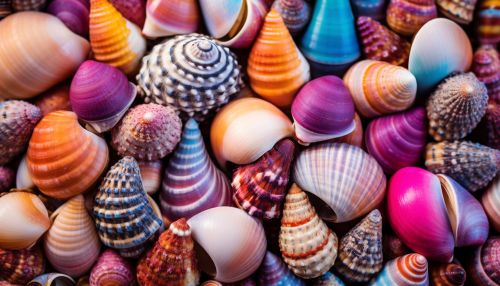Mollusca
Introduction
The Mollusca are a large phylum of invertebrate animals whose members are known as mollusks. This group includes a diverse range of species, with over 85,000 recognized extant taxa, making it the second-largest phylum of invertebrate animals after the Arthropods. The members of this phylum are characterized by soft, unsegmented bodies, most of which are enclosed in a hard shell.


Anatomy and Morphology
Mollusks exhibit a wide range of morphological diversity, but they all share certain common features. The body of a mollusk is generally divided into three main parts: the head, the visceral mass, and the foot. The head usually contains the mollusk's sensory organs, while the visceral mass contains the internal organs. The foot is a muscular organ primarily used for locomotion.
Head
The head of a mollusk typically contains the brain, eyes, and mouth. The brain, located in the head, is a complex organ that controls the mollusk's behavior and responses to the environment. The eyes of mollusks vary greatly in complexity, ranging from simple light-sensitive spots to complex, camera-like eyes similar to those of vertebrates. The mouth of a mollusk is equipped with a unique feeding structure known as the radula, which is used to scrape or cut food before it is swallowed.
Visceral Mass
The visceral mass of a mollusk contains the digestive, reproductive, and respiratory systems. The digestive system typically includes a stomach, intestine, and liver. The reproductive system varies greatly among different groups of mollusks, with some species being hermaphroditic (possessing both male and female reproductive organs) and others having separate sexes. The respiratory system of mollusks typically involves gills, although some terrestrial species have lungs.
Foot
The foot of a mollusk is a muscular structure used for locomotion. In some species, the foot is used for crawling, while in others it is adapted for burrowing, climbing, or swimming. The foot also often plays a role in capturing prey and in some cases, it is modified to form tentacles, as in cephalopods.
Classification
Mollusks are classified into several classes, including Gastropoda (snails and slugs), Bivalvia (clams, oysters, and other bivalves), Cephalopoda (squid, octopuses, and cuttlefish), and Polyplacophora (chitons). Each of these classes is characterized by distinct anatomical and behavioral features.
Gastropoda
Gastropods are the most diverse class of mollusks, with over 60,000 species. They are characterized by a single, usually coiled shell and a body that undergoes torsion during development. Gastropods include both marine and terrestrial species.
Bivalvia
Bivalves are a class of mollusks that includes clams, oysters, and mussels. They are characterized by a shell that is divided into two hinged parts. Bivalves are mostly marine, but there are also many freshwater species.
Cephalopoda
Cephalopods are a class of mollusks that includes squid, octopuses, and cuttlefish. They are characterized by a well-developed head, large eyes, and tentacles. Cephalopods are exclusively marine and are known for their high level of intelligence compared to other invertebrates.
Polyplacophora
Polyplacophorans, commonly known as chitons, are a class of mollusks that have a shell composed of eight separate shell plates. They are exclusively marine and are known for their ability to cling tightly to rocky substrates.
Ecology and Life History
Mollusks occupy a wide range of ecological niches, from deep sea to high mountain habitats, and from the tropics to the poles. They play significant roles in their ecosystems, often serving as key prey items for a variety of animals and contributing to nutrient cycling through their feeding and burrowing activities.
Mollusks exhibit a wide range of life histories. Some species have relatively short lifespans and rapid reproductive rates, while others live for many years and reproduce slowly. Many mollusks are capable of both sexual and asexual reproduction.
Human Interaction
Mollusks have long been of importance to humans, serving as a source of food, ornamentation, and materials. Many species of mollusks, particularly bivalves and gastropods, are harvested for food. Pearls, produced by certain species of oysters, have been prized for their beauty for thousands of years. Mollusk shells have been used by various cultures for ornamentation, tools, and currency.
However, human activities have also had negative impacts on mollusk populations. Overharvesting, habitat destruction, pollution, and the introduction of invasive species have all contributed to declines in mollusk populations. Conservation efforts are underway to protect and restore mollusk populations.
